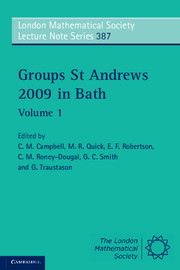Book contents
- Frontmatter
- Contents
- Introduction
- A speech in honour of John Cannon and Derek Holt
- Finite groups of Lie type and their representations
- Iterated monodromy groups
- Engel elements in groups
- Some classes of finite semigroups with kite-like egg-boxes of D-classes
- Structure of finite groups having few conjugacy class sizes
- Group theory in cryptography
- A survey of recent results in groups and orderings: word problems, embeddings and amalgamations
- A survey on the minimum genus and maximum order problems for bordered Klein surfaces
- On one-relator quotients of the modular group
- Miscellaneous results on supersolvable groups
- Automorphisms of products of finite groups
- A rational property of the irreducible characters of a finite group
- Automotives
- On n-abelian groups and their generalizations
- Computing with matrix groups over infinite fields
- Trends in infinite dimensional linear groups
- Engel conditions on orderable groups and in combinatorial problems (a survey)
- References
Trends in infinite dimensional linear groups
Published online by Cambridge University Press: 05 July 2011
- Frontmatter
- Contents
- Introduction
- A speech in honour of John Cannon and Derek Holt
- Finite groups of Lie type and their representations
- Iterated monodromy groups
- Engel elements in groups
- Some classes of finite semigroups with kite-like egg-boxes of D-classes
- Structure of finite groups having few conjugacy class sizes
- Group theory in cryptography
- A survey of recent results in groups and orderings: word problems, embeddings and amalgamations
- A survey on the minimum genus and maximum order problems for bordered Klein surfaces
- On one-relator quotients of the modular group
- Miscellaneous results on supersolvable groups
- Automorphisms of products of finite groups
- A rational property of the irreducible characters of a finite group
- Automotives
- On n-abelian groups and their generalizations
- Computing with matrix groups over infinite fields
- Trends in infinite dimensional linear groups
- Engel conditions on orderable groups and in combinatorial problems (a survey)
- References
Summary
Abstract
In this paper we present a short survey discussing some recent results in the theory of infinite dimensional linear groups.
Introduction
In this paper R will denote a ring, G will denote a group and A will be a right RG–module. When R is a field, we shall denote it by F and, of course, A is then also a vector space over F. The group GL(F,A), of all F-automorphisms of A, and its subgroups, are called linear groups. Linear groups have played a very important role in algebra and other branches of mathematics. If dim FA (the dimension of A over F) is finite, n say, then a subgroup G of GL(F, A) is called a finite dimensional linear group. It is well known that in this case GL(F,A) can be identified with the group of all invertible n × n matrices with entries in F. The subject of finite dimensional linear groups is among the most studied branches of mathematics, having been built using the interplay between algebraic, geometrical, combinatorial and other methods. This theory is rich in many interesting and important results.
However, the study of the subgroups of GL(F,A) in the case when A has infinite dimension over F has been much more limited and normally requires some additional restrictions. One natural type of restriction to use here is a finiteness condition. The most fruitful example of such restrictions to date has undoubtedly been that of finitary linear groups.
- Type
- Chapter
- Information
- Groups St Andrews 2009 in Bath , pp. 271 - 282Publisher: Cambridge University PressPrint publication year: 2011
References
- 4
- Cited by



